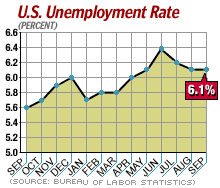NEW YORK (CNN/Money) -
U.S. payrolls grew in September for the first time in eight months, defying forecasts for more job losses and encouraging Wall Street, but many economists warned it was too early to break out the champagne.
“ This report is good news but it's still not strong enough to declare victory. ”
Anthony Chan
Banc One Investment Advisors
|
Unemployment held steady at 6.1 percent in September, the Labor Department reported, while payrolls outside the farm sector rose by 57,000 jobs after falling a revised 41,000 in August. It was the first gain for payrolls since 158,000 in January.
Economists, on average, expected unemployment to rise to 6.2 percent and payrolls to shrink by 30,000 jobs, according to a Reuters poll.
"This report is good news because it says the labor market is turning the corner, but it's still not strong enough to declare victory," said Anthony Chan, chief economist at Banc One Investment Advisors.
Wall Street cheered the news, sending stock prices higher, while Treasury bond prices tumbled as investors bet interest rates would start rising as economic growth picks up.
Many on Wall Street viewed the report as evidence that a self-sustaining recovery had started, which is when rising demand boosts production, boosting the need for labor, fueling wage growth and in turn more demand -- a so-called virtuous cycle.

The labor market has been mired in its longest slump since World War II, with payrolls 2.7 million jobs lighter than they were in March 2001, when the latest recession began. Though the recession ended in November 2001, according to the National Bureau of Economic Research, there has been no consistent job growth.
While Wall Street reacted with glee to Friday's report, many economists urged caution. For one thing, most economists believe 125,000 new jobs a month are needed for several months to bring unemployment down significantly.
"Good news is when we get gains of 100,000 or 200,000 -- [September's] number could very easily be revised to negative 57,000," Richard Yamarone, chief economist at Argus Research, told CNNfn. "One month does not a trend make."
What's more, the household survey, which generates the unemployment rate and has been cited by some economists as a better indicator of the labor market after periods of weakness, showed a loss of 52,000 jobs. A separate Labor Department survey of businesses is used for the payroll numbers.
| 
| |

| 
| 
|

|
 Labor secretary Elaine Chao comments on September unemployment numbers and what we might expect for the job market. Labor secretary Elaine Chao comments on September unemployment numbers and what we might expect for the job market.
|
 Play video
Play video
(Real or Windows Media)
|
| 
|

|
|
Nine million people were unemployed in September, the department said, 2.1 million of whom have been out of work for 27 weeks or longer. The average duration of unemployment was 19.7 weeks and in recent months has been the longest since 1984.
The hardship of unemployed people has become a political problem for President Bush, up for re-election in 2004. His father lost a re-election bid in 1992 because of a "jobless" economy, and Bush's predicament has been even worse -- since he took office in January 2001, 2.6 million jobs have been lost. He's likely to be the first president since Herbert Hoover to see a net job loss during his four-year term.
Speaking in Milwaukee, President Bush welcomed the report, suggesting his tax cut plan was helping to create jobs, but noting there was still room for improvement.
Critics of the administration's economic policies say the tax cuts are not creating nearly the kind of job growth the president has promised.
Hiring still on hold
While the worst of the economy's job-cutting is probably over, companies haven't started hiring in great numbers yet, and many economists believe it could take several months for the unemployment rate to fall significantly.
| Related stories
|

|
|
|
|
"Unemployment is not coming down enough, and payrolls are moving in a zig-zag fashion, with payroll numbers down one month, up another, with no consistency of job growth," Kathleen Camilli, economist at Credit Suisse Asset Management, told CNNfn. "This is still a mixed bag."
Manufacturing continued to shed jobs, losing 17,000 in September. Service payrolls rose by 74,000, most of those in the department's "professional and business services" category, which includes temporary help services, which added 33,000 jobs.
Many economists believe that increased temporary hiring is a good sign for the future health of the labor market, since many businesses will hire temps as the last step before making more permanent hires.
Other economists note that temp hiring -- which has risen for several months in a row -- might be more of a sign of lingering business caution.
On a negative note, average hourly wages fell a penny to $15.45 from $15.46 in August. Wage growth is critical to the strength of consumer spending, which fuels more than two-thirds of the economy.
The average work week was flat at 33.7 hours, indicating businesses held activity steady in September. More encouragingly, manufacturing hours rose to 40.4 from 40.2 in August.

|

